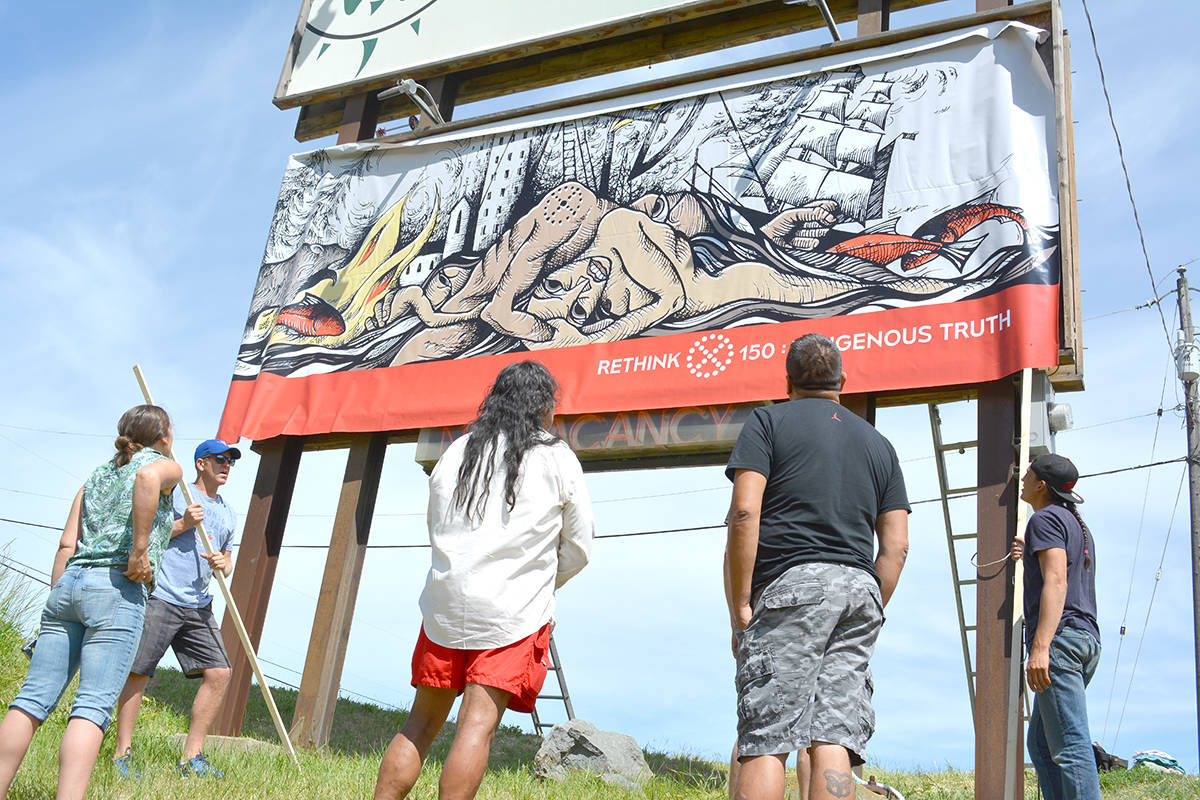A billboard stands at the north end of Duck Lake in Kelowna, presenting powerful images of an alternative perspective to the Canada 150 celebrations planned for this year
The vision shows Okanagan/Syilx peoples forming the land with their bodies, a medicine wheel rests on a man’s shoulder, a tall ship represents the encroaching colonialists, oil runs through the waters and flames lick at a church in the background.
Bears and salmon sit on the outer edge of the board and at the bottom lies the words “Rethink 150: Indigenous Truth.”
Two billboards were created by members of the Rethink 150: Indigenous Truth Collective and have been erected in the the Okanagan to foster reconciliation between Syilx/Okanagan people and non-indigenous Canadians.
The first billboard was unveiled in May on a Lower Similkameen Indian Band reserve near Keremeos.
The second can be seen on Highway 97 at the north end of Duck Lake near Kelowna, on Okanagan Indian Band reserve land and was placed Saturday, June 17.
The artist who created the design, Crystal Przybille, grew up in the Okanagan. But she wasn’t aware of the indigenous history before she began researching a previous historic sculpture.
“Part of my research for that sculpture brought me to a sort of raised awareness of the problematics of settlement, of colonialism and of indigenous culture that was here in the valley,” she said.
The research led her to the Westbank First Nation, and then to a connection with the indigenous truth collective.
Przybille wants to create a dialogue with the billboards, showing the marginalization of indigenous peoples amid the celebrations of Canada’s 150th birthday.
“For a whole culture of people it was an incredibly painful 150 years and let’s think about that,” she said.
The image was developed through conversations with the Syilx people and the collective, determining what 150 years means to them, she said.
Dixon Terbasket is a member of the Syilx Okanagan tribe and the Rethink 150 Collective. Terbasket and his family wanted to bring the dark history of Canada and its aboriginals to light.
“Here in the Okanagan it’s a little different, it’s harder to see. We’re urbanized, we’re surrounded by the settlers, for lack of a better term,” he said. “(But) there’s a lot of things we have on reserves. People are poor, they have health issues. People say ‘why don’t you just get over it?’ (or call us lazy.) I’ve worked hard all my life.
“There’s so many things that haven’t been told; the history of the Okanagan people itself.”
The billboards are supposed to make people think, he said, adding he hopes people will be curious about the billboard, with its visual message, and start asking questions.
“It’s made to make to make you uncomfortable if you know the history. You can see the anguish and despair in those faces,” said Terbasket.
The billboard will stand for two months on the side of highway. Northbound traffic have a chance to see it before they enter Lake Country. The collective has been developing the project since January, which was created through fundraising efforts.
